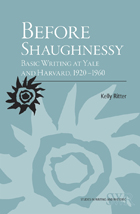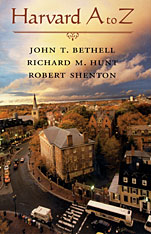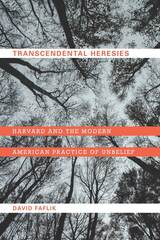
In Before Shaughnessy: Basic Writing at Yale and Harvard, 1920–1960, Kelly Ritter uses materials from the archives at Harvard and Yale and contemporary theories of writing instruction to reconsider the definition of basic writing and basic writers within a socio-historical context. Ritter challenges the association of basic writing with only poorly funded institutions and poorly prepared students.
Using Yale and Harvard as two sample case studies, Ritter shows that basic writing courses were alive and well, even in the Ivy League, in the early twentieth century. She argues not only that basic writers exist across institutional types and diverse student populations, but that the prevalence of these writers has existed far more historically than we generally acknowledge.
Uncovering this forgotten history of basic writing at elite institutions, Ritter contends that the politics and problems of the identification and the definition of basic writers and basic writing began long before the work of Mina Shaughnessy in Errors and Expectations and the rise of open admissions. Indeed, she illustrates how the problems and politics have been with us since the advent of English A at Harvard and the heightened consumer-based policies that resulted in the new admissions criteria of the early twentieth-century American university. In order to recognize this long-standing reality of basic writing, we must now reconsider whether the nearly standardized, nationalized definition of “basic” is any longer a beneficial one for the positive growth and democratic development of our first-year writing programs and students.

Open this book and step into the storied corridors of the nation’s oldest university; encounter the historic landmarks and curiosities; and among them, meet the famous dropouts and former students, the world-class scholars, eccentrics, and prodigies who have given the institution its incomparable character.
An alphabetical compendium of short but substantial essays about Harvard University—its undergraduate college and nine professional schools—this volume traverses the gamut of Harvardiana from Aab and Admissions to X Cage and Z Closet. In between are some two hundred entries written by three Harvard veterans who bring to the task over 125 years of experience within the university. The entries range from essential facts to no less interesting ephemera, from the Arnold Arboretum designed by Frederick Law Olmsted to the peculiar medical specimens of the Warren Museum; from Arts and Athletics to Towers and Tuition: from the very real environs (Cambridge, Charles River, and Quincy Street) to the Harvard of Hollywood and fiction.
Harvard A to Z is a browser’s delight, offering readers the chance to dip into the history and lore, the character and culture of America’s foremost institution of higher learning.


Dean of the Harvard Medical School and School of Public Health in the 1920's and '30's,David Edsall was one of the leaders in a period of great change and progress in medicine. At the beginning of Edsall's career, a doctor's chief weapons were his informed mind and trained senses. By the end of it, the permanent alliance of the sciences and medicine had profoundly altered the doctor's practice and his education. It was a time of struggle, of conflict, and of enduring accomplishment.
Edsall was at the center of this revolutionary effort in three leading schools of medicine: the University of Pennsylvania, Washington University in St. Louis, and Harvard. He began his career in Pennsylvania as recording clerk to the famous Dr. William Pepper, Jr., at the same time making scientific contributions in metabolism through his work in the Pepper Laboratory of Clinical Medicine. By 1907 he had become Professor of Therapeutics and Pharmacology. In 1910 and '11, for one stormy year, he was the school's Professor of Medicine. This was a key year -in 1910 the publication of Abraham Flexner's Medical Education in the United States and Canada had led to the eradication of one quarter of U. S. medical schools and radical reform of many others.
From Pennsylvania Edsall went to St. Louis as Professor of Preventive Medicine, and his part in the reform of that medical school is both controversial and fascinating.
,Edsall's appointment in 1912 to a double post at Harvard and the Massachusetts General Hospital brought him to Boston -the field of his major contributions. This remarkable period was the day of such people as Harvard's Walter Cannon, Otto Folin, Harvey Cushing, Alice Hamilton, L. J. Henderson. It saw the founding of the School of Public Health, the major endowment of the Medical School. In his ten years at the hospital and his seventeen years as dean, as in his influence as a trustee of the Rockefeller Foundation, Edsall gave direction to many developments in American medicine which bear his mark to this day.

As president of Harvard University, Neil Rudenstine has enjoyed a unique perspective on the state of higher learning, while exerting a significant influence on its recent and future course. Published to commemorate his decade-long tenure, this selection of Rudenstine’s talks and writings illuminates many of the ideas and issues that animate higher education today.
In a collection of more than fifty speeches and writings, Rudenstine eloquently explores topics both timely and timeless, from the educational importance of diversity to the enduring value of the humanities; from the teaching potential of new technologies to the profound benefits of basic research; from developments in the professions and public service to the singular power of education to transform lives.
Specially designed and printed in a limited edition, Pointing Our Thoughts features a foreword by Hanna Holborn Gray, President Emeritus of the University of Chicago and a member of the Harvard Corporation. As Gray remarks, “To read [Rudenstine’s] thoughtful and beautifully crafted speeches is to hear the voice of a teacher deeply committed to the vocation of opening minds to reflection and insight, listening intensely to his colleagues and entering with them into a continuing process of intellectual dialogue, sharing the convictions and perplexities of the search for understanding.” This volume is testament to that commitment. It represents an invaluable addition to the literature on higher education in America and around the world.

This one-volume history of Harvard is not so much a summary of Samuel Eliot Morison’s monumental work [The Tercentennial History of Harvard College and University, 1636–1936] as it is an entirely fresh handling of his vast material.
With a mind saturated in the lore and tradition at his command, Professor Morison has sat down to tell the whole story of Harvard informally and briefly. Documentation and all the learned apparatus of scholarly research are therefore omitted; but the same genial humor, the same ability to see the human implications of past events, that characterize his larger, multi-volume series on Harvard are preserved in this. The result is a marvelously entertaining volume, the history of Harvard that everyone has been waiting for, a model of vitalized historical writing.

Transcendental Heresies draws on an expansive antebellum archive of period commentary and writings by transcendentalism's practitioners, including Ralph Waldo Emerson, Henry David Thoreau, Theodore Parker, Margaret Fuller, and the women of transcendentalism's second and third waves. From Boston to Concord to the heady environs of Harvard, the species of unbelief they practiced multiplied the religious possibilities of the era, expressing misgivings about traditional notions of divinity, flouting religion's customary forms, and ultimately encouraging spiritual questioning.

READERS
Browse our collection.
PUBLISHERS
See BiblioVault's publisher services.
STUDENT SERVICES
Files for college accessibility offices.
UChicago Accessibility Resources
home | accessibility | search | about | contact us
BiblioVault ® 2001 - 2024
The University of Chicago Press









